This set of Class 11 Biology Chapter 7 Multiple Choice Questions & Answers (MCQs) focuses on “Structural Organisation in Animals – Animal Tissues-3”.
1. Which of the following represents the intercellular matrix of cartilage?
a) Solid and pliable
b) Hard and non-pliable
c) Solid and non-pliable
d) Hard and pliable
View Answer
Explanation: The intercellular matrix of cartilage is solid and pliable and resists compression. Cartilage is present in the tip of the nose, outer ear joints, between adjacent bones of the vertebral column, limbs and hands in adults.
2. What does the question mark represent in the following diagram?
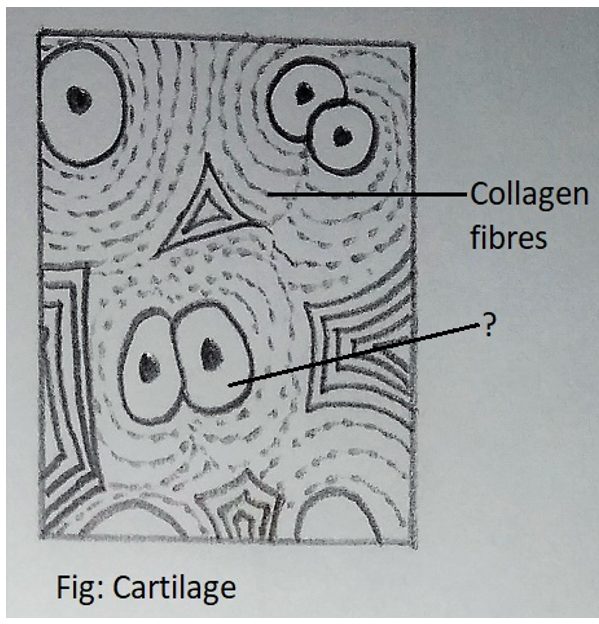
a) Osteocyte
b) Chondrocyte
c) Collagen cells
d) Lacunae
View Answer
Explanation: The question mark in the given diagram represents a chondrocyte or a cartilage cell. Cells of cartilage or chondrocytes are enclosed in small cavities within the matrix secreted by them. Most of the cartilages in vertebrate embryos are replaced by bones in adults.
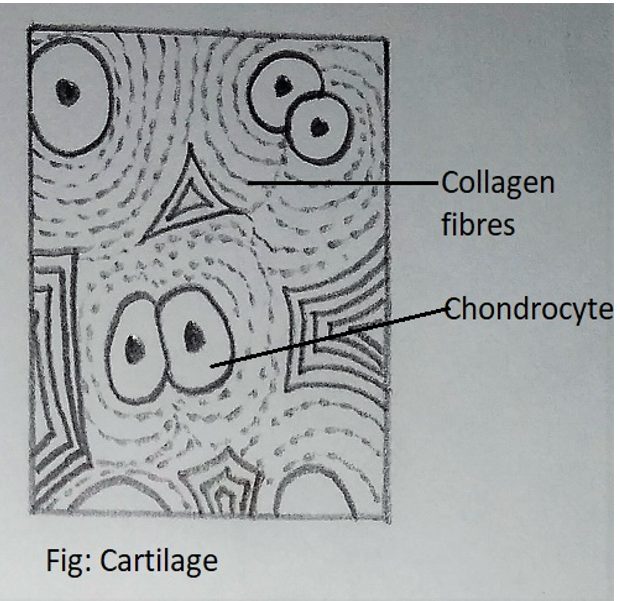
3. Which of the following represent the intercellular matrix of a bone?
a) Solid and pliable
b) Hard and non-pliable
c) Loose and non-pliable
d) Hard and pliable
View Answer
Explanation: Bones have a hard and a non-pliable ground substance rich in calcium salts and collagen fibres which give bone its strength. Also, the matrix of the bone is present in the form of layers called lamellae.
4. Cartilage is the main tissue that provides the structural frame to the body.
a) True
b) False
View Answer
Explanation: Bone is the main tissue that provides the structural frame to the body. Bones support and protect softer tissues and organs. Limb bones, such as the long bones of the legs, serve weight-bearing functions.
5. Which of the following tissue sections has been represented in the given diagram?
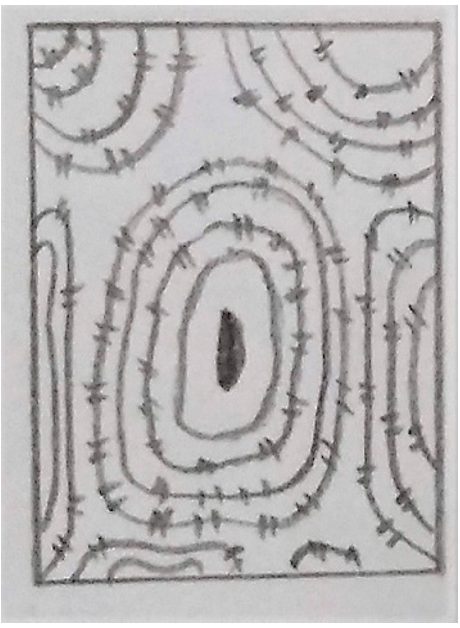
a) Cartilage
b) Muscle
c) Bone
d) Tendon
View Answer
Explanation: The given figure represents a section of the bone. The bone cells or the osteocytes are present in the spaces called lacunae. Haversian system in mammalian bones provides passage to the blood vessels, lymph vessels and nerve fibres which are present in the bone.
6. Which of the following is the main circulating fluid of the body?
a) Blood
b) Lymph
c) Water
d) Sebum
View Answer
Explanation: Blood is a fluid connective tissue containing plasma, red blood cells, white blood cells and platelets. It is the main circulating fluid that helps in the transport of various substances.
7. What does muscle fibres consist of?
a) Fibriliocytes
b) Short fibrils
c) Fibroblasts
d) Myofibrils
View Answer
Explanation: Each muscle is made up of many long, cylindrical fibres arranged in parallel arrays. These fibres are composed of numerous fine fibrils called myofibrils.
8. Muscles are of how many types?
a) One
b) Two
c) Three
d) Four
View Answer
Explanation: Muscles are of three types namely skeletal, smooth and cardiac muscles. Muscles play an active role in all the movements of the body.
9. Which of the following muscle is represented in the given diagram?
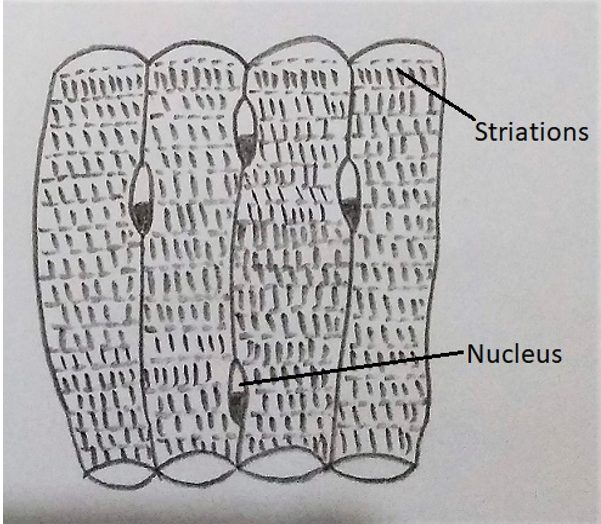
a) Skeletal muscle
b) Smooth muscle
c) Complicated muscle
d) Loose muscle
View Answer
Explanation: The given diagram represents the skeletal muscle. Skeletal muscles are closely attached to the skeletal bones. In a typical skeletal muscle, striated muscle fibres are bundled together in a parallel fashion.
10. What does the given figure represent?
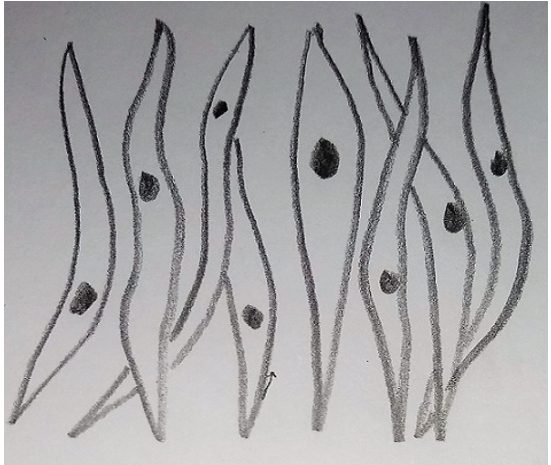
a) Skeletal muscle
b) Smooth muscle
c) Cardiac muscle
d) Simple muscle
View Answer
Explanation: The given figure represents smooth muscle or involuntary muscle. The smooth muscle fibres taper at both the ends and do not show striations. Cell junction holds them together and they are bundled together in a connective tissue sheath.
11. Which of the following is not the correct location of a smooth muscle?
a) Stomach
b) Bones
c) Blood vessels
d) Intestine
View Answer
Explanation: The wall of internal organs such as the blood vessels, stomach and intestine contain smooth muscles. They are involuntary as their functioning cannot be directly controlled.
12. Where are the cardiac muscles found?
a) Only in the heart
b) Around the heart
c) Outside the heart
d) Away from the heart
View Answer
Explanation: Cardiac muscle tissue is a contractile tissue present only in the heart. Cell junctions fuse the plasma membranes of cardiac muscle cells and make them stick together. Fastest contraction is seen in cardiac muscles.
13. What does the question mark in the given diagram represent?
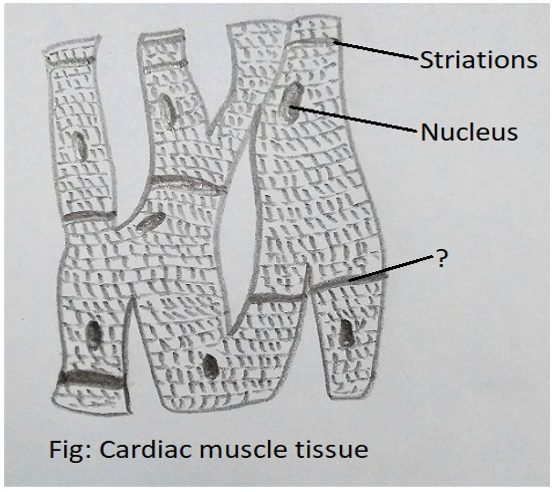
a) Striped muscles
b) Plasma membrane
c) Blood capillaries
d) The junction between adjacent cells
View Answer
Explanation: The question mark here represents the junction between the adjacent cells. Communication junctions or the intercalated discs at some points allow the cells to contract as a unit.
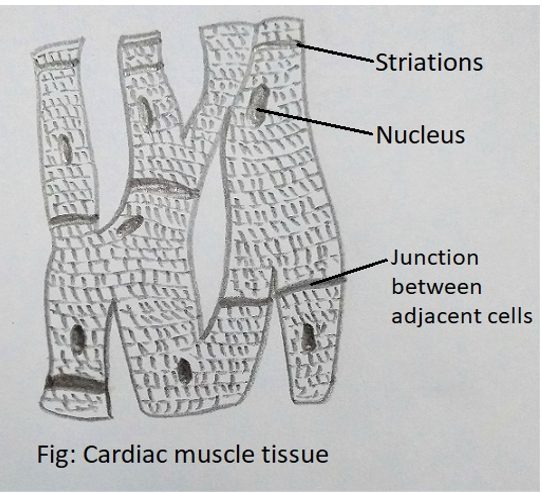
14. Which of the following tissue exerts the greatest control over the body?
a) Connective tissue
b) Muscular tissue
c) Neural tissue
d) Epithelial tissue
View Answer
Explanation: Neural tissue exerts the greatest control over the body’s responsiveness to changing conditions. Neurons, the unit of the neural system are excitable cells.
15. Which of the following cells make more than half the volume of neural tissue?
a) Microglial cells
b) Epithelial cells
c) Neuroglial cells
d) Macrophages
View Answer
Explanation: Neuroglial cells make up more than one-half the volume of neural tissue in our body. These cells protect, support and insulate the neurons. They do not conduct the impulse but they can divide and hence they have regeneration power.
Sanfoundry Global Education & Learning Series – Biology – Class 11.
To practice all chapters and topics of class 11 Biology, here is complete set of 1000+ Multiple Choice Questions and Answers.
If you find a mistake in question / option / answer, kindly take a screenshot and email to [email protected]
- Practice Class 12 - Biology MCQs
- Check Class 11 - Books
- Practice Class 11 - Physics MCQs
- Practice Class 11 - Chemistry MCQs
- Practice Class 11 - Mathematics MCQs
